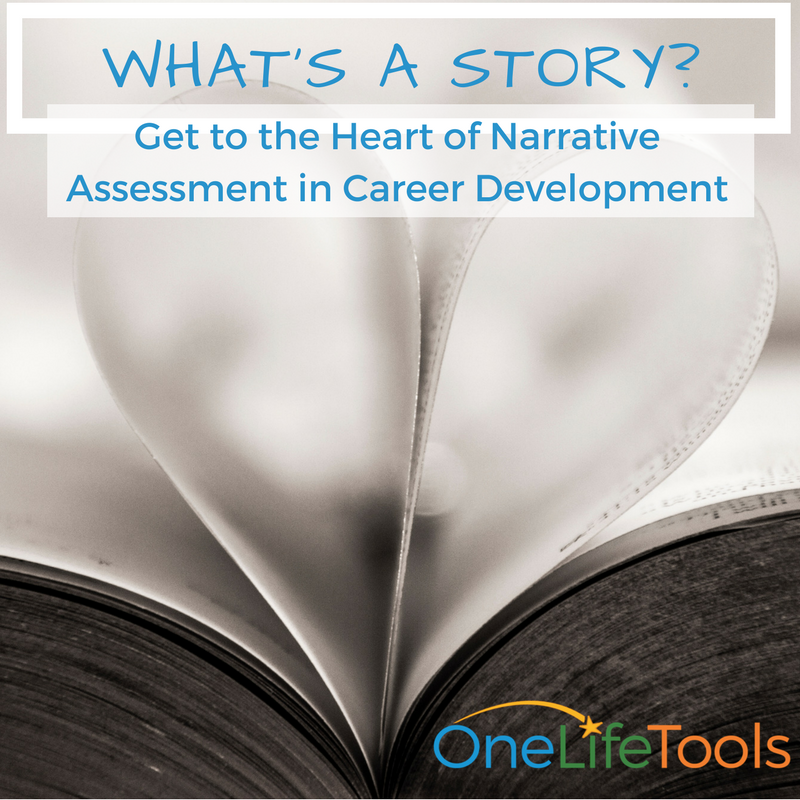Storytelling seems simple enough. You might envision a few people listening intently to each other around a campfire. Maybe you see a parent and child sharing a picture book. A great Ted Talk might stand out in your mind.
As narrative career practitioners, when we ask clients to tell us a story, it’s not that simple. Some ask “like a fairytale?” or “um...like an example of a task I perform at work?” We need to back up our request with the reasons why we’re asking. We need to provide a framework and a jumping off point from which they can begin to share.
Narrative assessment and therapy are part of a post-modern movement in the career development field that’s migrating away from ‘test-and-tell’ and job matching methods. From keeping clients engaged to honouring their personal context, narrative techniques have been proven to address major challenges in our field. They also increase psychological capital - namely hope, optimism, efficacy and resilience - in clients.
It’s powerful. It’s proven. And it can be hard to explain.
So what’s a story?
A story is a significant stage or experience within a client’s life. This could be a professional development experience or a meaningful volunteer gig. It can be a recent work experience or their first ‘real’ job. It can be broader too - a time that a client overcame a tough barrier, or a time when they felt like they won.
As psychologist John Dewey famously said: “we do not learn from experience, we learn from reflecting on our experiences”. Our role as helping professionals is to help clients debrief and learn from each of their stories, and to gain clarity as they reflect.

When we ask “tell me a story”, we must fully engage in storylistening, and then help clients identify key elements, from their desires to the influences of other people, that are embedded in these stories.
If we ask clients “what are your top 3 strengths?”, most fumble with the answer. We aren’t used to talking about ourselves. Championing our assets is not a skill we use every day, and for most of us, it’s uncomfortable. We don’t reflect, often or enough, to have these ready. How many rockstar clients do you have that deliver stellar interviews but get passed over for the job? Even clients that are good at playing the interview game that is the current norm in HR don’t always identify and communicate the right strengths that correlate to a particular role.
Through storytelling, we can ask instead: “what strengths did you draw from in this story to help you?”. That is an easier question to answer, and the answer is more potent, since it is rooted in a client’s personal context. They highlight their own strengths, within themselves and for themselves, by telling a story.

Storytelling leads to clarity
Often, clients understand the power of storytelling after their first or second experience of sharing a story. Once clients have told several stories using a narrative framework, patterns start to emerge. You can ask which strengths might be ‘signature strengths,’ those that if used daily, would make the client feel great? You can ask which of their stories surprised them, and what new possibilities for their future are connected to the surprise?
We move away from “what are your strengths and weaknesses” and “what’s on your resume?” to “what is most important to you now, based on the desires you shared in this story?”.
Navigating a career with only a traditional resume can limit change: it is like driving a car by looking only through the rear view mirror. If the road curves, you crash. Using narrative assessment with clients, which is present and future-oriented, opens them to change: it is looking at the road ahead, noticing clues and adapting to changing conditions while, at the same time, honouring what has come before.
Storytelling leads to reflection. Reflection leads to clarity. Why is that important? Because people that manage their careers with clarity end up in roles, companies and situations that make them happy and productive. They retain these jobs, they excel in what they have chosen to do, because they are clear about why they are doing it, why it is meaningful to them and why it matters in their lives.

A simple explanation
“What’s a story?”
A meaningful experience in your life.
“Why are you asking me for a story?”
So I can help you reflect on your past to gain clarity and momentum to move forward with intentional action and focus.
“What will I gain by telling you stories?”
A strategy, that you can draw on again and again, to help you navigate a lifetime of transitions and reflect on the meaning in your experiences.

Storytelling is the heart of Narrative Assessment. It’s powerful. It’s proven. And if you explain it in this way, the stories will flow.
How do you ask your clients for stories? How do you explain what’s at the heart of your narrative career approach? We’d love to hear your stories and best practices! Comment below or share with us on LinkedIn, Twitter and Facebook!


1 comment
Jul 31, 2018 • Posted by Cindy
I love the articles and looking forward to trying out your narrative assessment process on myself and then with my clients. It feels more like the full meal deal with the focus on hope for the future. It combines accountability with vision and aspiring for a solid happy future.
Leave a comment: